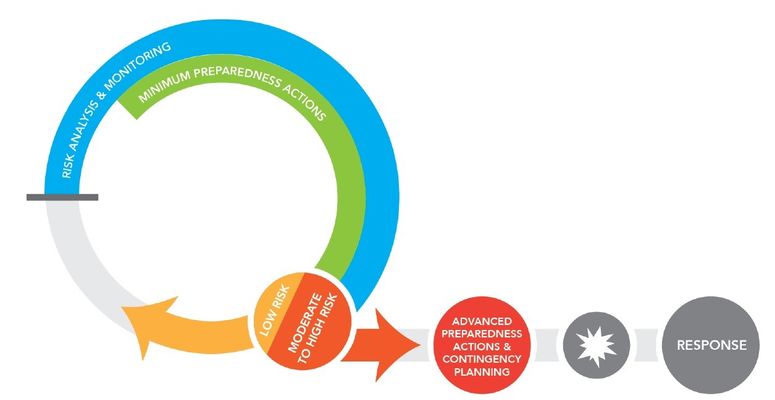Emergency Preparedness
Contribute to the multisector Emergency Response Preparedness (ERP) Plan
Sequencing of ERP components (2016 IASC ERP At a glance)
As per the IASC guideline, Emergency Preparedness Plan presents two parts:
- Minimum Preparedness Actions (MPA): to be systematically implemented in all countries and context
- Advanced Preparedness Actions and contingency plan: to be implemented for a specific risk when this risk has become very likely
The development of the ERP plan can be coordinated by OCHA in a cluster activated context. Intersectorial and sectorial ERP task forces should be created. WASH coordination platform must be the link between these two levels.
Coordinate the design and implementation of Minimum Preparedness Actions with the Inter-sector and the WASH ERP task force
In all countries and contexts, Minimum Preparedness Actions should be implemented by relevant agencies. They include:
- Risk monitoring and analysis: ERP can be defined as a process to manage risk. Risk must be listed and prioritized based on their likelihood and planned impact on human life. Key WASH market systems should be continously monitored (for instance water, fuel or construction material prices) in order to anticipate possible disruptions in availability of WASH goods and services.
- Plan standard coordination arrangements in case of disaster. This include early discussions with Cash Working Groups to increase readiness of WASH actors for cash based modalities.
- Plan standard for Information management arrangements in case of disaster
- Preparations for joint needs assessment if an emergency occurs. This can include the implementation of pre-crisis assessments of priority WASH markets, and set up arrangement for intersector emergency market assessment;
- Establishment of operational capacity to increase readiness. This step consists in identifying key WASH and other stakeholders (ERP task force) interested and capable to be involved in the process and create a dedicated group of partners, representative but small enough to be efficient.
- Mitigate/prevent risk: To mitigate and respond to the risks identified, an ideal level of capacity is needed from the WASH sector (NGOs, local authorities, local population etc.). The level of capacity of these stakeholders may not be sufficient, and capacity gaps are observed. The coordination platform must map these capacities to identify gaps and strengthen the sector.
Coordinate the design and implementation of Advanced Preparedness Actions with the Inter-sector and the WASH ERP task force, including contingency plan
When in a country a particular risk becomes high, it should triggers Advanced Preparedness Actions. They include:
- Reaching out to national counterparts, local partners, communities to coordinate preparedness plans and assess response capacity.
- Implementing WASH technical, coordination and market based programing training for the partners, based on the capacity assessment;
- Deploying appropriate coordination, information management, needs assessments and response monitoring systems and developing a sourcing strategy for priority relief items, prioritizing local markets when relevant;
- Organizing simulation exercises to increase readiness to respond;
- Contingency planning
A contingency plan is established only when a certain risk becomes likely. They are ideally intersectorial, but are usually composed of several sectorial plan to facilitate the coordination by clusters. A contingency plan will include the following information for the identified specific risk:
- Situation & Risk analysis: the identified risk must be monitored. Basic scenarios are developed based on how the expected disaster or emergency will evolve and the likely impact on the humanitarian situation and the corresponding intervention.
- Response strategy: what would be the WASH response logical framework analysis in case this risk occurs: objectives, results, activities, indicators
- Operational delivery: define what would be the geographical targeting, what would be the preferred aid delivery modality, what are the recommendations regarding using local markets etc.
- Coordination arrangement: agreed coordination structure, priority cluster to be activated, relationship with local government or military
- Operational support arrangement: arrangement regarding needs assessment, response monitoring, transport of material and team, security aspects
- Preparedness gaps and action: follow up on agencies preparedness actions
- Funding requirements: what would be the cost of the response, what would be the likely sources of funding, funds prepositioning
Monitor and evaluate the WASH part of the ERP plan
WASH coordination platforms monitor the implementation of preparedness actions by WASH partners, advocate in case delays or gaps are observed and regularly update the WASH ERP. After an emergency, the ERP must be reviewed or evaluated to understand what worked and what didn’t, and improve it.
